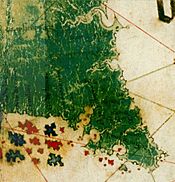Spanish Florida facts for kids
Quick facts for kids Governorate of Florida
La Florida (Spanish)
|
|||||||||||
|---|---|---|---|---|---|---|---|---|---|---|---|
| Territory of New Spain | |||||||||||
| 1513–1763 1783-1819 |
|||||||||||
|
Cross of Burgundy
|
|||||||||||
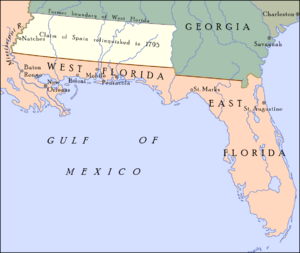 Spanish Florida after Pinckney's Treaty in 1795 |
|||||||||||
| Anthem | |||||||||||
| Marcha Real (Royal March) |
|||||||||||
| Capital | San Agustín | ||||||||||
| Government | |||||||||||
| • Type | Monarchy | ||||||||||
| • Motto | Plus Ultra transl. Further Beyond |
||||||||||
| History | |||||||||||
|
• Spanish exploration and settlement
|
1513–1698 | ||||||||||
|
• San Miguel de Gualdape establishment and abandonment
|
1526 | ||||||||||
|
• Initial Pensacola establishment, abandonment, and re-establishment
|
1559–1561; 1698 |
||||||||||
|
• Fort Caroline establishment and sacking
|
1564–1565 | ||||||||||
|
• St. Augustine establishment
|
1565 | ||||||||||
|
• Santa Elena establishment and abandonment
|
1566–1587 | ||||||||||
| 1763 | |||||||||||
| 1783 | |||||||||||
| 1795 | |||||||||||
| 1814 | |||||||||||
|
• Adams–Onís Treaty signed
|
1819 | ||||||||||
| 1821 | |||||||||||
|
|||||||||||
| Today part of | United States | ||||||||||
Spanish Florida (Spanish: La Florida) was the first big land claim by Europeans in North America. It was part of the Spanish Empire during the time when Spain was exploring and settling the Americas. At first, La Florida was much larger than today's state of Florida. It covered most of the southeastern United States. This included all of present-day Florida, plus parts of Georgia, Alabama, Mississippi, North Carolina, South Carolina, and Louisiana.
Spain claimed this huge area because of several large trips made in the 1500s. Many missions, settlements, and small forts were built in the 1500s and 1600s. But they were later left empty. This happened because English and French settlements grew, native populations decreased, and it was hard to grow enough food or make money. By the 1700s, Spain only controlled a few forts. These were near St. Augustine, St. Marks, and Pensacola. All of these are within the borders of present-day Florida.
Florida was not a very important area for Spain. It mainly served as a buffer zone. This buffer was between Mexico (called New Spain), Spain's Caribbean colonies, and the growing English colonies to the north. Unlike Mexico and Peru, there was no gold or silver to be found in Florida. Due to diseases and attacks by Carolina colonists and their Native American allies, the native population was not large enough for forced farm labor. So, Spain did not set up big farms in Florida. Large cattle ranches in north central Florida were the most successful farms. They supplied food to local areas and to Cuba. The coastal towns of Pensacola and St. Augustine also offered ports. Spanish ships could stop there for water or supplies.
Starting in the 1630s, a series of missions were built. They stretched from St. Augustine to the Florida panhandle. These missions supplied St. Augustine with maize (corn) and other food. The Apalachee people living at the missions had to send workers to St. Augustine every year. These workers did labor in the town. But these missions were destroyed by Carolina and Creek raiders between 1702 and 1704. This further reduced the native population and weakened Spain's control.
Britain took control of Florida in 1763. This was part of the agreements that ended the Seven Years' War. Most of the Spanish people moved to Cuba. The British divided the territory into East and West Florida. They offered free land to new settlers, but could not increase the population or economy much. Britain traded Florida back to Spain after the American War of Independence in 1783. Spain's control over the colony continued to weaken. After many attacks by American forces against the Seminole people in Florida, Spain decided to sell the territory to the United States. The Adams–Onís Treaty was signed in 1819. The transfer officially happened on July 17, 1821. This was over 300 years after Spain first claimed the Florida peninsula.
Contents
Spain Claims Florida: Early Explorations
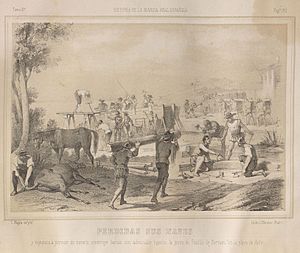
Spanish Florida began in 1513. This is when Juan Ponce de León claimed the Florida peninsula for Spain. It was the first official European trip to North America. Other explorers like Pánfilo Narváez and Hernando de Soto landed near Tampa Bay in the mid-1500s. They traveled north to the Appalachian Mountains and west to Texas. They were mostly looking for gold, but did not find much.
The fort of St. Augustine was started in 1565. It was on Florida's Atlantic coast. Many missions were built across the Florida panhandle, Georgia, and South Carolina in the 1600s. Pensacola was founded in 1698. It was on the western Florida panhandle. These settlements helped Spain claim the area.
Spain's control of Florida became easier as native cultures declined. Several Native American groups lived in Florida for a long time. These included the Timucua, Calusa, Tequesta, Apalachee, Tocobaga, and Ais people. Most of them fought against Spanish invasions. But conflicts with Spanish explorers, raids by Carolina colonists and their native allies, and especially European diseases caused a huge drop in the population of all indigenous peoples of Florida. By the early 1700s, large parts of the peninsula were mostly empty.
In the mid-1700s, small groups of Creek and other Native American refugees moved south into Spanish Florida. They had been forced off their lands by South Carolina settlements and raids. Later, African-Americans fleeing slavery from nearby colonies joined them. These new people, along with a few surviving native Floridians, eventually formed a new Seminole culture.
First Europeans Arrive in Florida
Juan Ponce de León is often said to be the first European to find Florida. But this might not be true. Spanish raiders from the Caribbean might have secretly visited Florida between 1500 and 1510. They may have captured and enslaved native Floridians. Also, the Portuguese Cantino planisphere map from 1502 and other European maps from the early 1500s show land near Cuba. Some historians think this land is Florida. This idea suggests that unknown Portuguese explorers were the first to map the southeastern part of what is now the United States, including Florida. However, many other historians disagree with this idea.
Ponce de León's Expedition to Florida
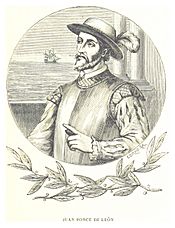
In 1512, Juan Ponce de León, who was the governor of Puerto Rico, got permission from the king to look for land north of Cuba. On March 3, 1513, his group left Puerto Rico with three ships. In late March, he saw a small island, probably one of the Bahamas, but did not land. On April 2, Ponce de León saw the east coast of the Florida peninsula. He landed there the next day, but the exact spot is now unknown.
He thought he had found a large island. He claimed the land for Spain and named it La Florida. He chose this name because it was the season of Pascua Florida ("Flowery Easter"). Also, many plants were blooming. After exploring the landing area, the group sailed south. They mapped the coast and met the Gulf Stream. They followed Florida's coast around the Florida Keys and north. They mapped part of the Southwest Florida coast before going back to Puerto Rico.
Ponce de León did not have many recorded meetings with Native Americans on his trip. But the people he met, likely the Timucua, Tequesta, and Calusa, were mostly unfriendly at first. They knew a few Spanish words. This suggests they had already been visited by Spanish raiders.
A popular story says that Ponce de León was looking for the Fountain of Youth when he found Florida. However, the first time someone said he was looking for water to cure his aging (he was only 40) was after his death. This was more than twenty years after his trip. The first time the Fountain of Youth was placed in Florida was thirty years after that. It is much more likely that Ponce de León, like other Spanish conquistadors in the Americas, was looking for gold, land to colonize for Spain, and Native Americans to convert to Christianity or enslave.
Other Early Spanish Journeys
Other Spanish trips to Florida happened soon after Ponce de León returned. Between 1514 and 1516, Pedro de Salazar led a raid. It was approved by the government. He enslaved about 500 Native Americans along the Atlantic coast of the southeastern United States. Diego Miruelo mapped what was probably Tampa Bay in 1516. Francisco Hernández de Cordova mapped most of Florida's Gulf coast to the Mississippi River in 1517. Alonso Álvarez de Pineda sailed and mapped the central and western Gulf coast to the Yucatán Peninsula in 1519.
First Attempts to Settle Florida
In 1521, Ponce de León sailed from Cuba with 200 men and two ships. He wanted to start a colony on the southwest coast of Florida. This was probably near Charlotte Harbor. But attacks by the native Calusa people forced the colonists away in July 1521. During a fight, Ponce de León was hurt in his leg. He later died from his injuries when the group returned to Havana.
In 1521, Pedro de Quejo and Francisco Gordillo enslaved 60 Native Americans at Winyah Bay, South Carolina. Quejo, with help from Lucas Vázquez de Ayllón, returned to the area in 1525. They stopped at several places between Amelia Island and the Chesapeake Bay. In 1526, de Ayllón led about 600 people to the South Carolina coast. After looking at possible spots as far south as Ponce de Leon Inlet in Florida, they started the settlement of San Miguel de Gualdape. It was near Sapelo Sound, Georgia. But disease, hunger, cold, and Native American attacks caused San Miguel to be abandoned after only two months. About 150 survivors went back to Spanish settlements.
Narváez Expedition's Difficult Journey
In 1527, Pánfilo de Narváez left Spain with five ships and about 600 people. His goal was to explore and settle the Gulf of Mexico coast. This was between existing Spanish settlements in Mexico and Florida. After storms and delays, the group landed near Tampa Bay on April 12, 1528. They already had few supplies, with about 400 people left. Narváez was confused about Tampa Bay's location. He sent his ships to find it. Most of the group marched north, hoping to meet the ships at the bay.
Narváez marched close to the coast, through mostly empty land. The group had to live on the food they brought. They finally met Native Americans at the Withlacoochee River. They took hostages and reached the Native Americans' village. There, they found corn. Further north, they met a chief named Dulchanchellin. He led them to his village across the Suwannee River. The chief tried to get the Spanish to help him fight his enemies, the Apalachee.
The Spanish took Native Americans as guides. They traveled northwest towards the Apalachee land. The guides might have led the Spanish through difficult areas. The group did not find the larger Apalachee towns. By the time they reached Aute, a town near the Gulf Coast, Native American archers had been attacking them for many days. Narváez's group was sick, low on food, and facing hostile Native Americans. He decided to sail to Mexico instead of marching. Two hundred and forty-two men sailed on five simple rafts. All the rafts were wrecked on the Texas coast. After eight years, four survivors, including Álvar Núñez Cabeza de Vaca, reached New Spain (Mexico).
De Soto's Search for Riches
Hernando de Soto was a main leader for Francisco Pizarro in the Spanish conquest of the Inca Empire. He returned to Spain a very rich man. He was made Adelantado (a type of governor) of Florida and governor of Cuba. He put together a large group to 'conquer' Florida. On May 30, 1539, de Soto and his group landed in Tampa Bay. There, they found Juan Ortiz. He had been captured by local Native Americans ten years earlier. Ortiz told de Soto about Native American stories of riches, including gold, in Apalachee. De Soto set off with 550 soldiers, 200 horses, and some priests.
De Soto's group lived off the land as they marched. De Soto followed a path further inland than Narváez's group. But the Native Americans remembered the earlier problems caused by the Spanish. They were careful, or even hostile. De Soto took Native Americans to be guides and porters.
The group reached Apalachee in October. They stayed in the main Apalachee town of Anhaica for the winter. They found a lot of stored food, but little gold or other riches. In the spring, de Soto went northeast. He crossed what is now Georgia and South Carolina into North Carolina. Then he turned west, crossed the Great Smoky Mountains into Tennessee. Then he marched south into Georgia. Turning west again, the group crossed Alabama. They lost all their supplies in a fight with Native Americans near Choctaw Bluff on the Alabama River. They spent the winter in Mississippi. In May 1541, the group crossed the Mississippi River. They wandered through present-day Arkansas, Missouri, and possibly Kansas. They spent the winter in Oklahoma. In 1542, the group headed back to the Mississippi River, where de Soto died. Three hundred and ten survivors returned from the trip in 1543.
Establishing Settlements and Forts
Spain decided to build permanent settlements and forts in Florida. This was because of the challenge from French Florida. In 1562, French captain Jean Ribault led a trip to Florida. He built Charlesfort on what is now Parris Island, South Carolina. But the French Wars of Religion stopped Ribault from returning with supplies. So, the men left the fort. Two years later, René Goulaine de Laudonnière, Ribault's helper, set out to create a safe place for Protestant Huguenot colonists in Florida. He founded Fort Caroline in July 1564, near what is now Jacksonville. Again, Ribault's supply mission failed to arrive, putting the colony in danger. Some rebels left Fort Caroline to become pirates against Spanish colonies. This worried the Spanish government. Laudonnière almost left the colony in 1565. But Jean Ribault finally arrived with supplies and new settlers in August.
At the same time, King Philip II of Spain appointed Pedro Menéndez de Avilés as Adelantado of Florida. His job was to remove all non-Spanish adventurers from the land. This land stretched from Newfoundland to St. Joseph Bay (on the north coast of the Gulf of Mexico). Menéndez de Avilés reached Florida in 1565, at the same time as Ribault. He set up a base at San Agustín (St. Augustine in English). This is the oldest continuously inhabited European-established settlement in what is now the continental United States.
Menéndez de Avilés quickly moved to attack Fort Caroline. He traveled overland from St. Augustine. At the same time, Ribault sailed from Fort Caroline, planning to attack St. Augustine from the sea. However, a strong storm pushed the French fleet out to sea and destroyed many ships. Meanwhile, the Spanish easily took over the lightly defended Fort Caroline. They only spared the women and children. About 25 men managed to escape. When the Spanish returned south and found the French shipwreck survivors, Menéndez de Avilés ordered all the Huguenots killed. This place became known as Matanzas.
In 1565, Luisa de Abrego, a free black servant from Seville, married Miguel Rodríguez, a white Spanish soldier, in St. Augustine. This was the first known Christian marriage recorded in what is now the continental United States.
After the French were driven out, the Spanish renamed Fort Caroline to Fort San Mateo. Two years later, Dominique de Gourgues recaptured the fort from the Spanish. He killed all the Spanish defenders. But he did not leave soldiers there. France did not try to settle in Florida again.
To make St. Augustine stronger, Spaniards built the Castillo de San Marcos. They used forced labor from the Timucuan, Guale, and Apalache peoples. Construction started in 1672 and finished in 1695. They also built Fort Matanzas to the south. This fort helped them watch for enemies coming by sea. In the 1700s, a free black population grew in St. Augustine. Spanish Florida offered freedom to enslaved people who escaped from the Thirteen Colonies. Fort Mose became another fort. It was home to free black soldiers and their families. It served as a protective barrier between the Spanish and British.
Missions and Conflicts in Florida
In 1549, Father Luis de Cáncer and three other Dominicans tried the first mission trip focused only on religion in La Florida. For decades, Native Americans had met Spanish laymen who ignored a 1537 Papal Bull (a church order) that strongly spoke against slavery. This religious group's effort ended after only 6 weeks. Father de Cáncer was brutally killed by Tocobaga natives. His death greatly affected the Dominican missionaries in New Spain for many years.
In 1566, the Spanish started the colony of Santa Elena on what is now Parris Island, South Carolina. Juan Pardo led two trips (1566-1567 and 1567-1568) from Santa Elena. He went as far as eastern Tennessee. He built six temporary forts inland. The Spanish left Santa Elena and the surrounding area in 1587.
In 1586, English privateer Francis Drake attacked and burned St. Augustine. This included a fort that was being built. He did this while returning from raiding Santo Domingo and Cartagena in the Caribbean. His attacks showed that Spain could not properly defend its settlements.
The Jesuits started building missions for Native Americans in Florida in 1567. But they left in 1572 after bad encounters with the natives. In 1573, Franciscans took over the missions to Native Americans. They eventually ran dozens of missions for the Guale, Timucua, and Apalachee tribes. The missions faced conflicts. The Guale first rebelled on October 4, 1597, in what is now coastal Georgia.
The mission system also helped militarily. It was a strategic advantage against British troops coming from the North. Over more than a hundred years of mission growth, European diseases greatly affected the natives. The power of the French and British also grew. During the Queen Anne's War, the British destroyed most of the missions. By 1706, the missionaries left their mission outposts and went back to St. Augustine.
Friendship and Further Conflicts
Spanish Governor Pedro de Ibarra worked to make peace with the native cultures south of St. Augustine. There is a record of his meeting with important Native American chiefs. In 1605, Ibarra sent Álvaro Mexía, a mapmaker, on a mission further south. His goal was to meet and build good relationships with the Ais Native American nation, and to map the area. His mission was successful.
In February 1647, the Apalachee revolted. This revolt changed the relationship between Spanish leaders and the Apalachee. After the revolt, Apalachee men were forced to work on public projects in St. Augustine or on Spanish-owned ranches. In 1656, the Timucua rebelled. This disrupted the Spanish missions in Florida. It also affected the ranches and food supplies for St. Augustine.
The economy of Spanish Florida became more varied in the 1600s. Cattle ranching became very important. Throughout the 1600s, colonists from the Carolina and Virginia colonies slowly pushed the border of Spanish Florida south. In the early 1700s, French settlements along the Mississippi River and Gulf Coast moved into the western parts of the Spanish claim.
Starting in 1680, Carolina colonists and their Native American allies repeatedly attacked Spanish mission villages and St. Augustine. They burned missions and killed or kidnapped Native American people. In 1702, James Moore led an army of colonists and Native Americans. This force included Yamasee, Tallapoosa, Alabama, and other Creek warriors. They were led by the Yamasee chief Arratommakaw. The army attacked and destroyed the town of St. Augustine. But they could not take control of the fort. In 1704, Moore made a series of raids into the Apalachee Province of Florida. He looted and destroyed most of the remaining Spanish missions. He also killed or enslaved most of the Native American population. By 1707, the few surviving Native Americans had fled to Spanish St. Augustine and Pensacola, or French Mobile. Some of the Native Americans captured by Moore's army were moved to areas along the Savannah and the Ocmulgee rivers in Georgia.
In 1696, the Spanish had founded Pensacola near the old site of Ochuse. In 1719, the French captured the Spanish settlement at Pensacola.
Some Spanish men married or had children with Pensacola, Creek, or African women. These women were both enslaved and free. Their descendants created a mixed-race population of mestizos and mulattos. The Spanish encouraged enslaved people from the southern colonies to come to Florida for safety. They promised freedom if they became Catholic and served in the colonial army. King Charles II of Spain made a royal announcement. It freed all enslaved people who fled to Spanish Florida and accepted conversion and baptism. Most went to the area around St. Augustine. But escaped enslaved people also reached Pensacola. St. Augustine had an all-black military unit defending Spain as early as 1683.
During the 1700s, the Native American peoples who would become the Seminoles started moving to Florida. The area had been mostly emptied by Carolina and Yamasee slave raids. Carolina's power was hurt, and the colony was almost destroyed during the Yamasee War of 1715–1717. After this, the Native American slave trade changed a lot.
Spanish Florida was a place where enslaved people from the Thirteen Colonies could escape. The Spanish leaders offered them freedom if they became Catholic and joined the colonial army. This policy became official in 1693.
British Control of Florida

In 1763, Spain traded Florida to Great Britain. In return, Spain got control of Havana, Cuba, and Manila in the Philippines. The British had captured these places during the Seven Years' War. Britain had defeated France in the war. So, Britain took over all of French Louisiana east of the Mississippi River, except for New Orleans. This new territory was too big to govern as one area. So, Britain divided the southernmost parts into two territories. These were separated by the Apalachicola River. They were called East Florida (the peninsula) and West Florida (the panhandle).
Most of the Spanish people left Florida after the treaty was signed. All of St. Augustine's residents moved to Cuba.
The British soon started a strong plan to attract colonists to the area. They offered free land and support for businesses that sold goods to other countries. In 1764, the British moved the northern border of West Florida. It went from the mouth of the Yazoo River east to the Chattahoochee River (32° 22′ north latitude). This area included about the lower third of today's states of Mississippi and Alabama. It also included the valuable Natchez District.
During this time, Creek Native Americans began to move into Florida. This led to the formation of the Seminole tribe. The original peoples of Florida had been greatly reduced by war and disease. Most survivors are thought to have gone with the Spanish settlers when they left for other colonies in 1763. This left large areas of land open for the Lower Creeks. They had been fighting with the Upper Creeks of Alabama for years. The Seminole first lived in the wooded areas of northern Florida. Because of pressure from colonists and the United States Army in the Seminole Wars, they moved into central and southern Florida, to the Everglades. Many of their descendants live in this area today. They are one of the two federally recognized Seminole tribes in the state.
Britain kept control over East Florida during the American Revolutionary War. But the Spanish, who were allied with the French, recaptured most of West Florida. At the end of the war, the Peace of Paris (1783) treaties gave all of East and West Florida back to Spanish control. However, the exact borders were not clearly stated.
Spain Regains Control: The Second Spanish Period
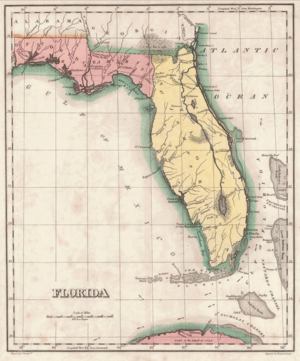
Spain got West Florida and regained East Florida from Britain in the Peace of Paris of 1783. Spain continued to govern the Floridas as separate territories: West Florida and East Florida. When Spain got West Florida in 1783, the eastern British border was the Apalachicola River. But Spain moved it eastward to the Suwannee River in 1785. The goal was to move San Marcos and the Apalachee district from East Florida to West Florida.
After American independence, the unclear borders caused a dispute with the new United States. This was known as the West Florida Controversy. The two treaties in 1783 that ended the American Revolutionary War had different borders. The Treaty of Paris between Britain and the United States set the border between West Florida and the new U.S. at 31°. However, in the other Peace of Paris treaty between Britain and Spain, West Florida was given to Spain without its borders being specified. The Spanish government thought the border was the same as in the 1763 agreement. By that agreement, they had first given their Florida territory to Britain. Spain claimed the northern border of West Florida was at the 32° 22′ line. Britain had set this line in 1764 after the Seven Years' War. The British line at 32° 22′ was close to Spain's old claim of 32° 30′. The now independent United States insisted the border was at 31°, as stated in its Treaty of Paris with Britain.
After American independence, Spain claimed much more land than the old British West Florida. This included the east side of the Mississippi River north to the Ohio and Tennessee rivers. This larger claim was based on Spain's successful military actions against the British in the area during the war. Spain occupied or built several forts north of the old British West Florida border. These included Fort Confederación, Fort Nogales (at today's Vicksburg), and Fort San Fernando (at today's Memphis). Spain tried to solve the dispute quickly. But the U.S. waited, knowing that time was on its side. By Pinckney's Treaty of 1795 with the United States, Spain agreed to the 31st parallel as the border. This ended the first West Florida Controversy. Andrew Ellicott surveyed this parallel in 1797. It became the border between the United States and Spanish territories. In 1798, Ellicott told the government that four American generals were getting money from Spain, including General James Wilkinson.
Spain had many independence movements in its other colonies. By the early 1800s, it could not properly settle or govern Florida. Its control was limited to areas near towns and forts across the north of the territory. Tensions and hostility grew between Seminoles and American settlers in nearby Georgia and across the Florida border. Slaveholders wanted to get back enslaved people who had escaped. Slave raiders often entered the territory. They attacked Seminole villages and tried to capture Black Seminoles. British agents in Florida gave weapons and help to Native Americans. This led to raids across the border. Sometimes, American forces had to step in.
Several local uprisings and military actions against Spanish rule happened. Some had quiet support from the U.S. government. The most notable was the Patriot War of East Florida from 1810–1812. It was led by George Mathews. In 1817, a mixed group of American and Scottish adventurers, Latin American revolutionaries, and pirates from Texas attacked Fernandina. They temporarily claimed all of Amelia Island for the revolutionary republic of Mexico for several months. Then U.S. forces took back the island. They held it "in trust" for Spain until Spain could "properly police and govern it." U.S. Secretary of State John Quincy Adams told Spain to control Florida. He called the territory "a derelict open to the occupancy of every enemy, civilized or savage, of the United States, and serving no other earthly purpose than as a post of annoyance to them."
The United States Army made more and more frequent attacks against the Seminoles in western Florida. The most notable was an 1817–1818 campaign led by Andrew Jackson. It became known as the First Seminole War. During this conflict, Jackson occupied Pensacola. Spain protested this until it was returned to Spanish control a few weeks later. By 1819, the United States effectively controlled much of the Florida panhandle. Spain was willing to discuss transferring the entire territory. The Adams–Onís Treaty was signed between the United States and Spain on February 22, 1819. It became official on July 17, 1821. Under the treaty, the United States gained Florida and all Spanish claims to the Oregon Country. In return, the U.S. gave up all its claims to Texas. It also agreed to pay all Spanish debts to American citizens, which totaled about $5 million.
Hundreds of Black Seminoles escaped from Cape Florida to the Bahamas in the early 1820s. They did this to avoid U.S. slave raiders.
Images for kids
-
An excerpt from the British–American Mitchell Map, showing northern Spanish Florida, the old mission road from St. Augustine to St. Mark's, and text describing the Carolinian raids of 1702–1706.
See also
 In Spanish: Florida española para niños
In Spanish: Florida española para niños



